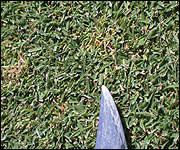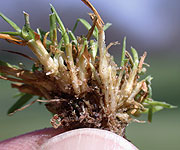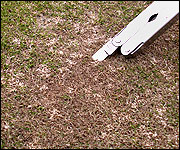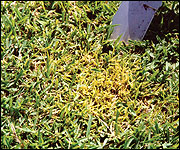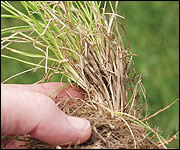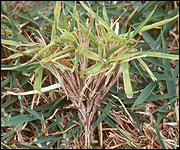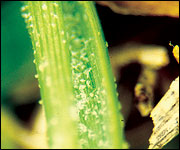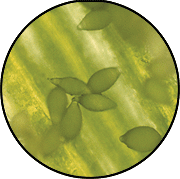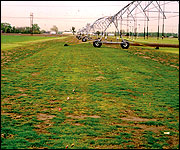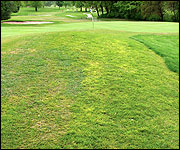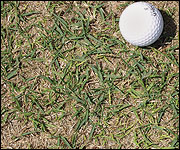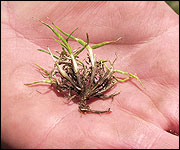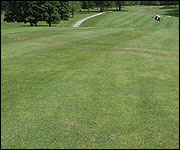Yellow tuft
Symptoms and signs | Conditions | Management
Yellow tuft is a cool-season disease that is commonly observed on creeping bentgrass and intensively managed Kentucky bluegrass. On creeping bentgrass greens, the disease is generally more cosmetic than damaging, although the disease is chronic in some locations. Yellow tuft can result in serious loss of quality in zoysiagrass sod production and on zoysiagrass green surrounds.
Pathogen
- Sclerophthora macrospora
Hosts
- Creeping bentgrass
- Kentucky bluegrass
- Annual bluegrass
- Zoysiagrass
- Others less common
Symptoms can be confused with those of
- Nutrient deficiency
Symptoms and signs
On bentgrass or annual bluegrass putting surfaces, yellow tuft occurs as bright yellow spots ranging in diameter from 1/2 to 1 inch (Figure 1). The spots are individual plants infected with Sclerophthora macrospora, which results in the production of many more tillers than normal (Figure 2). The excess tillering is a condition commonly known as tufting. Tufted plants are shallowly rooted and easily removed from the turf surface. In some regions, infected plants are prone to winterkill, probably as a result of heaving due to the shallow roots (Figure 3).
Yellow spots in Kentucky bluegrass or zoysiagrass are larger than those seen on putting surfaces, depending on turfgrass density and height of cut (Figure 4). Where normal creeping bentgrass and Kentucky bluegrass commonly have fewer than eight tillers, infected plants have 15 or more (Figure 5). In infected zoysiagrass, the excess tillering is often associated with individual nodes rather than individual plants. Infected zoysiagrass can have 30 or more tillers per node in contrast to the normal three to four (Figure 6).
Under cool moist conditions in spring and fall, S. macrospora produces sporangia (fruiting bodies) on turfgrass leaves. Sporangia are best seen early in the morning under heavy dew. They are pearly white and give a downy appearance to leaf surfaces when viewed with a hand lens. The sporangia are ephemeral, quickly collapsing when the leaf surface dries. In the field it is more common to see the collapsed sporangia as a gray to white crystalline residue on the leaf surface (Figure 7 top). When turgid, the sporangia are lemon shaped (Figure 7 bottom) and contain zoospores (motile spores). Zoospores swim in free moisture to infect adjacent healthy meristematic tissue in just a few hours. Oopores (sexual spores) are sometimes produced in infected leaf tissue but are more numerous and easier to detect in crabgrass species.
In zoysiagrass sod fields and on zoysiagrass surrounds, infected stands are often thin and yellow as the grass breaks dormancy in the spring (Figures 8, 9 and 10 top). Infected zoysiagrass is stunted and extensively tufted (Figure 10 bottom). On zoysiagrass fairways, the disease often appears as a more diffuse yellowing without extensive tufting (Figure 11). Yellow tuft of zoysiagrass is more severe on shaded areas of fairways.
Conditions
Yellow tuft is favored by cool (41 to 68 degrees F), wet conditions. Severe symptoms can occur in low-lying, poorly drained areas of sod production fields or fairways. In turf prone to periodic flooding, especially in the spring or fall, S. macrospora infection is likely.
Crabgrass is very susceptible to yellow tuft, and large numbers of oospores, which serve as a source of inoculum, are produced in infected tissues. Sod production fields with heavy crabgrass pressure can have a greater incidence of yellow tuft.
Management
Improve drainage as needed to remove water quickly. Where a chronic problem exists, address issues of poor drainage first.
Maximum susceptibilty to S. macrospora infection occurs when cool, wet weather coincides with the period when the turfgrass is producing the maximum amount of meristematic tissue for regrowth. For cool-season grasses already established on fairways and greens, this period occurs in spring and fall. On thinned areas in zoysiagrass surrounds, this period begins in the spring and continues as long as the turf manager is fertilizing to encourgae the zoysiagrass to fill in and the temperatures are generally below 70 degrees F. In sod production fields, this period may occur anytime after harvest as the sod producer is managing the zoysiagrass to regenerate. High temperatures and low relative humidity, however, may reduce severity of infection.
Although fosetyl-Al and mefenoxam are labeled for management of yellow tuft, mefenoxam is usually the more effective. Fungicide should be applied beginning at the period of maximum susceptibility and repeated as needed. On zoysiagrass, core cultivate just before fungicide application to facilitate fungicide placement near meristematic tissue developing on rhizomes. The goal of fungicide application is to protect the new growth. Fungicide application will have no effect on grass that has already produced excess tillers.
